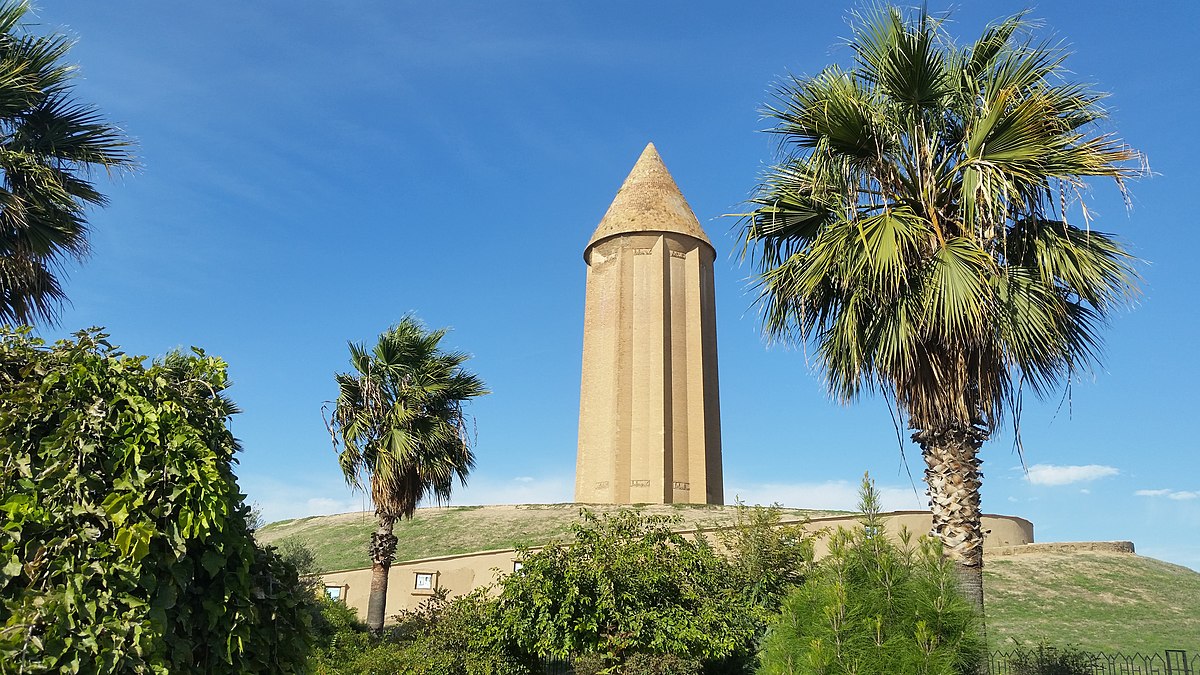Table of Contents
Gonbad-e Qabus, also known as Gonbad-e Kavus, showcases the beauty of Islamic architecture dating back to the fourth century AD. This UNESCO World Heritage site in Iran is a towering structure, reaching 15 meters above the ground. It was constructed in 375 Solar Hijri during the rule of Qabus-ibn Wushmgir, making it a remarkable feat of craftsmanship and symmetry.
Despite its simple adornments, this spot impresses with its balanced design and strong build. It’s fascinating how such a straightforward building can capture attention, standing as the tallest brick tower globally. As people gaze upon its impressive stature, they’re transported to a time of architectural ingenuity and cultural significance.
Gonbad-e Qabus is a reminder of our rich heritage and the remarkable skills of ancient builders, leaving a lasting impression on all who visit.
Gonbad-e Qabus History
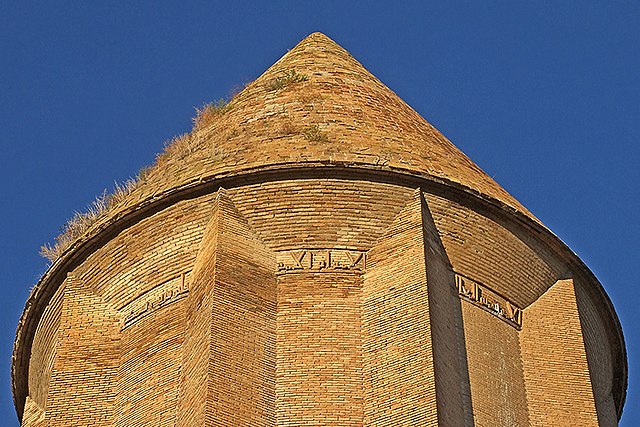
Just a short journey from Gorgan city, Golestan Province, you’ll find the brick-towering Gonbad-e Qabus/Gonbad-e Kavus. This massive brick structure, standing 53 meters tall, is known as the dome of Qabus. It’s named after Qabus Ibn Voshmgir, a smart ruler from the Ziyarid dynasty. Qabus wrote a book called the Qaboosnameh for his son, Gilanshah, to guide him in ruling wisely after him. The tower is where Qabus rests now, his wisdom echoing through the pages of his book. This spot intrigued Robert Byron, a British writer, prompting him to explore Iran’s rich history.
Gonbad-e Qabus isn’t just a tall tower; it’s a symbol of family and wisdom. As you stand before it, you can feel the bond between father and son. This place isn’t just about bricks; it’s about passing on knowledge and love from one generation to the next. It reminds us of a time when wisdom was cherished above all else. This tower stands tall, not just as a monument, but as a reminder of the enduring power of learning and love that connects us all.
Gonbad-e Qabus Meaning
In the world of Persian history, Gonbad-e Qabus is a special sight. It’s basically a big dome named after someone called Qabus. But nowadays, referring to Gonbad e Qabus meaning, people call it the “tower of Kavus.” The Iranian government decided this name change back in the 1930s, connecting it to another nearby city called Astarabad. Despite this switcheroo, this location still has that old-time charm, drawing folks in with its timeless stories and cool looks.
Looking at this brick tower, you can’t help but think about the olden days. This ancient building has seen a lot over the years. Every brick and curve in its dome holds stories of the people who lived long ago. Even though some folks tried to change its name, it stays the same, reminding us of its ancient roots and inviting us to step back in time.
Gonbad-e Qabus Structure
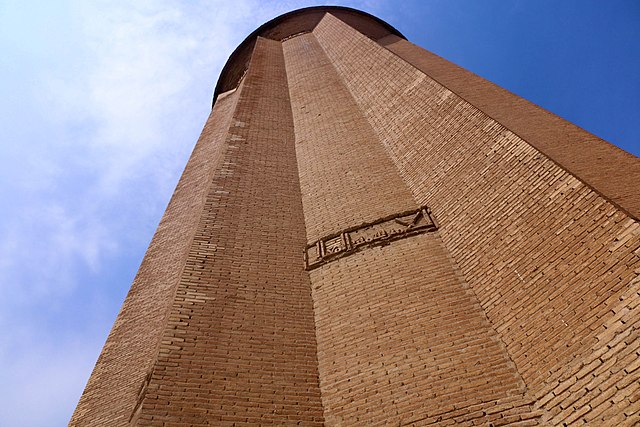
Gonbad-e Qabus Structure, located in Iran, is a remarkable example of ancient architecture that has stood the test of time. Built using baked bricks and combining early Razy and Khorasan styles, this tower stands tall at 52 meters with a circular shape and a pointed roof. Divided into three parts, let’s explore its fascinating construction.
Foundation
At the base of Gonbad-e Qabus lies a 10-meter-tall man-made hill. Made from bricks and traditional Iranian concrete called “Sarooj,” it once housed a cellar, though much of its contents have been taken by looters over the years.
Body
Rising from the foundation, the tower’s body is surrounded by angled buttresses, casting striking shadows against the sky. With only one entrance facing southeast, adorned with decorative niches, it showcases early examples of intricate architectural features.
Conical Roof
At the top, the tower boasts a conical roof standing 18 meters tall. Crafted with the same baked bricks as the rest of the structure, it adds to the tower’s imposing presence and timeless appeal.
Gonbad-e Qabus Horse Riding Fields
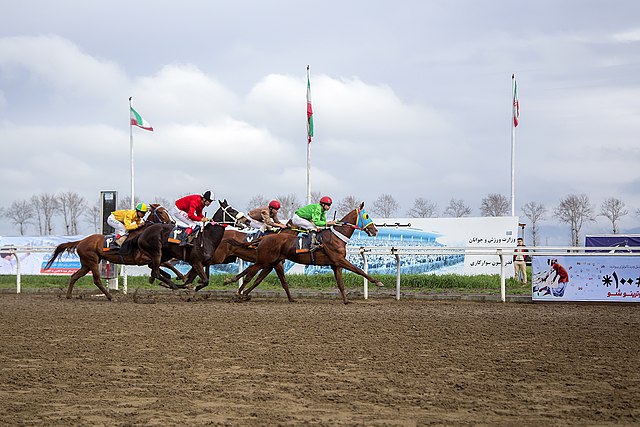
Located in the northeast of Gonbad-e Qabus, the Gonbad-e Qabus Horse Riding Fields are a true spectacle. People from all over the world come to watch these exciting competitions held every Thursday and Friday in spring and autumn. Established in 1961, the equestrian complex hosts between 3,000 to 7,000 spectators who gather to see the action unfold on the 1400-meter oval track.
The people of Gonbad-e Qabus and Bandar Torkaman have a long history of horseback riding, which has become a cherished part of their culture. In 1971, during the Pahlavi era, the construction of the Gonbad Equestrian Complex was ordered, solidifying horse racing as a special event.
Since 2001, the Turkmen Golden Horseshoe CHF has been instrumental in organizing these competitions, where eighty to ninety horses participate each week. As the horses race around the track, cheered on by excited crowds and the announcer’s booming voice, the atmosphere is electric. If you’re drawn to the excitement of horse riding, be sure to visit Gonbad-e Qabus in the spring or autumn to witness this thrilling sport in action.
How to Get to Gonbad-e Qabus
To reach Gonbad-e Qabus, just drive from Gorgan in the northeast of the country. Enjoy the scenic route and explore charming villages along the way. It’s a journey filled with beauty and discovery.
Recommended Sightseeing Time of Gonbad-e Qabus
In Gonbad-e Qabus, the weather swings from chilly winters to hot summers. Winters bring cold, dry days sometimes wrapped in fog, while summers are scorching and clear. The yearly average temperature ranges from 38 to 96 degrees Fahrenheit, rarely going below 29 or above 103.
If you’re planning to visit Gonbad-e Qabus comfortably, aim for the period from early June to late September. During this time, you can enjoy hot-weather activities and soak in the city’s unique vibe without worrying about extreme temperatures.
Where to Eat Near Gonbad-e Qabus
Wisteria Cafe
In Gonbad-e Qabus, Wisteria Cafe stands out for its beauty and friendly service. Step inside and enjoy the cozy atmosphere filled with the scent of freshly brewed coffee. With a lovely decor and polite staff, it’s the perfect spot for a delicious meal.
Cafe Cadre
Nearby, Cafe Cadre offers a cozy retreat with a varied menu for breakfast, lunch, and dinner. Enjoy a warm ambiance and a choice of coffee or herbal teas. It’s a welcoming place to satisfy your cravings in Gonbad-e Qabus.
Where to Stay Near Gonbad-e Qabus
Hotel Ajam
Hotel Ajam in Gonbad-e Qabus offers a hassle-free stay with free parking, breakfast, and internet. Some rooms have kitchens for added convenience, and the hotel provides tour and ticket services. With housekeeping and porter assistance, guests can relax and enjoy their time in the city.
Sasang Roof Residence
Sasang Roof Residence provides an authentic, eco-friendly experience in Gonbad-e Qabus. Guests can enjoy freshly baked bread made by the host in the traditional way. Surrounded by nature, the residence offers a peaceful retreat for those looking to reconnect with simplicity and enjoy the present moment.
Nouray Ecolodge
Nouray Ecolodge, just a short drive from Kalaleh City in Golestan Province, offers a peaceful escape from city life. Inspired by traditional Turkmen homes, the lodge is decorated with local designs, creating a cozy atmosphere. Surrounded by natural beauty, guests are encouraged to relax and enjoy the simplicity of rural living at Nouray Ecolodge.
Other Attractions Near Gonbad-e Qabus
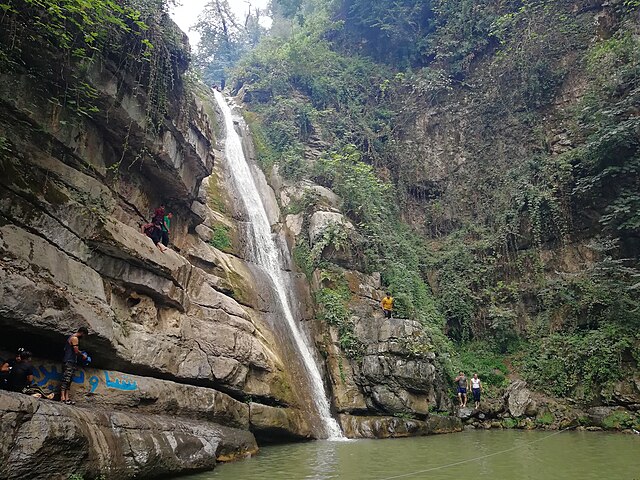
Tomb of Khaled Nabi
In the southeast of Gonbad-e Kavoos, there’s a special spot called the Tomb of Khaled-e Nabi. It sits on top of Kooh-e Khoda, also known as “The Mountain of God,” offering amazing views. People around here believe it’s where a prophet named Khalid was buried, along with two of his followers. This place has become a pilgrimage site for Iranians because of its religious importance and beautiful surroundings. There’s also a unique cemetery called Khaled Nabi Cemetery known as one of the most mysterious cemeteries in Iran with its strange graves.
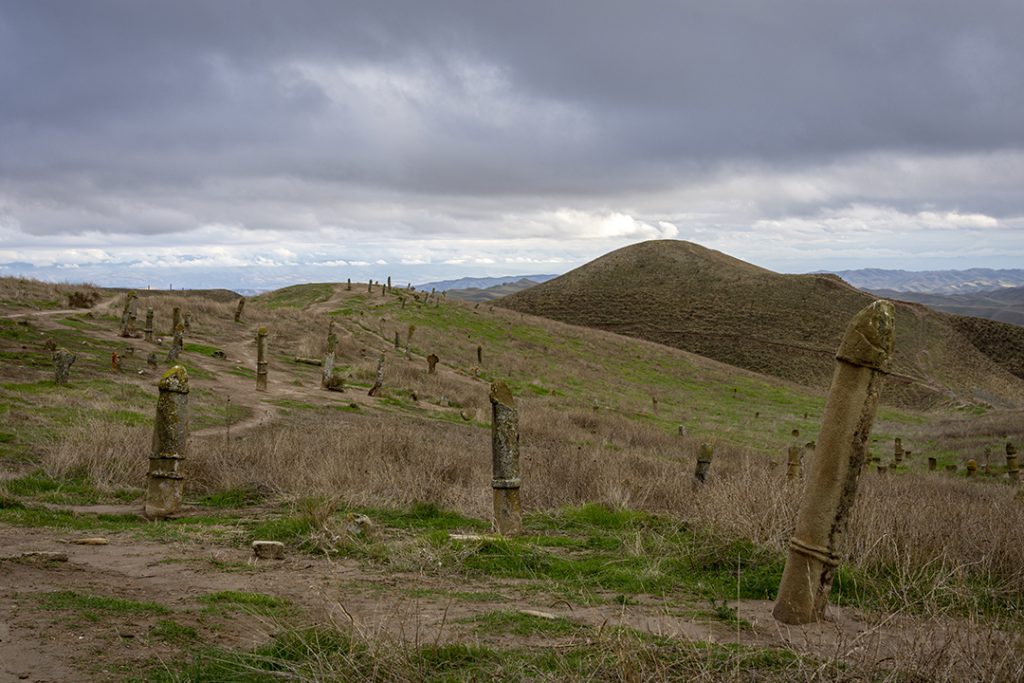
Carpet Museum of Gonbad Kavus
In the heart of downtown Gonbad Kavous stands the Gonbad Kavous Carpet Museum, also called the Turkman Specialty Museum. It’s the third carpet museum established in Iran, after Tehran and Mashhad. Next to the tallest brick tower globally, this museum holds a treasure trove of Turkmen carpets, showcasing 25 handmade pieces waiting to be discovered by the public.
Inside the museum, visitors are greeted with a stunning display of craftsmanship. These Turkmen carpets feature over 811 designs and symbols, some dating back thousands of years. What makes them unique are their geometric patterns, similar to the famous Bukhara style. As you wander through this floral wonderland, you’ll not only admire the beauty of these Persian carpets but also connect with the rich heritage they represent, adding a touch of history to your visit.
ShirAbad Waterfall
Just 7 kilometers south of Khanbebin town in Golestan Province lies the breathtaking Shirabad waterfall. Tucked away in the Alborz mountain slopes amidst dense forests, this natural marvel is a sight to behold. Along the path to the waterfall, you’ll encounter a charming spring in Iran, enhancing the journey’s beauty.
The Shirabad waterfall resembles a majestic staircase, boasting 12 waterfalls of varying sizes. The tallest one reaches a remarkable height of 30 meters, while the accompanying lake plunges to depths between 40 and 80 meters. As you marvel at nature’s splendor, you’ll be enchanted by the peaceful atmosphere and stunning views, making Shirabad waterfall a must-see spot for anyone who loves the great outdoors.
FAQs about Gonbad-e Qabus
Q1: What is the meaning of Gonbad?
A1: “Gonbad” is the Persian term for the dome, typically found on mosques. In Arabic, it’s known as “Qubba.” It’s a key element of Islamic art and architecture, easily recognizable.
Q2: Who built the Gonbad e Qabus Tower?
A2: The tomb, standing at 53 meters tall, was constructed in the year 1006 for Qābus Ibn Voshmgir, who was a ruler and intellectual of the Ziyarid dynasty. It’s located near the remains of the old city of Jorjan in northeastern Iran. This structure highlights the cultural connections between the nomadic people of Central Asia and the ancient civilization of Iran.
Q3: What is the significance of Gonbad-e Qabus?
A3: Gonbad-e Qabus is significant for its remarkable feat of craftsmanship and symmetry, serving as a symbol of family, wisdom, and the enduring power of learning. It stands as the tallest brick tower globally and is a reminder of our rich heritage and cultural significance.
Q4: What is the structure of Gonbad-e Qabus?
A4: It features a circular shape with a pointed roof, built using baked bricks and early Razy and Khorasan architectural styles. It consists of a 10-meter-tall foundation, a body surrounded by angled buttresses, and an 18-meter-tall conical roof.
Q5: How can visitors reach Gonbad-e Qabus?
A5: Visitors can reach there by driving from Gorgan, enjoying the scenic route, and exploring charming villages along the way.
Last Words: Experience the Best of Gonbad-e Qabus with a Customized Tour
Gonbad-e Qabus, also known as Gonbad-e Kavus, is a tall tower in Iran, standing 15 meters high. This UNESCO World Heritage Site was built around the fourth century AD, during the time of Qabus-ibn Wushmgir. Despite its simple decorations, the tower impresses with its strong design and sturdy build. It’s remarkable how such a basic structure can be the tallest brick tower globally. When people see it, they’re reminded of ancient times and how clever people were back then. Gonbad-e Qabus is a symbol of our past and the amazing skills of ancient builders.
Exploring Gonbad-e Qabus in Iran is an exciting journey that’s best experienced with a customized tour. These customized tours ensure your trip fits your preferences perfectly. Meet To Iran Tour: experts in organizing trips to Iran. We understand Gonbad-e Qabus’s attractions well. Our goal is to create a tour that matches your interests. Whether you’re fascinated by the ancient tower, the serene gardens, or the rich history, we design your itinerary to include what you love.
Let To Iran Tour guide you on an amazing adventure.

